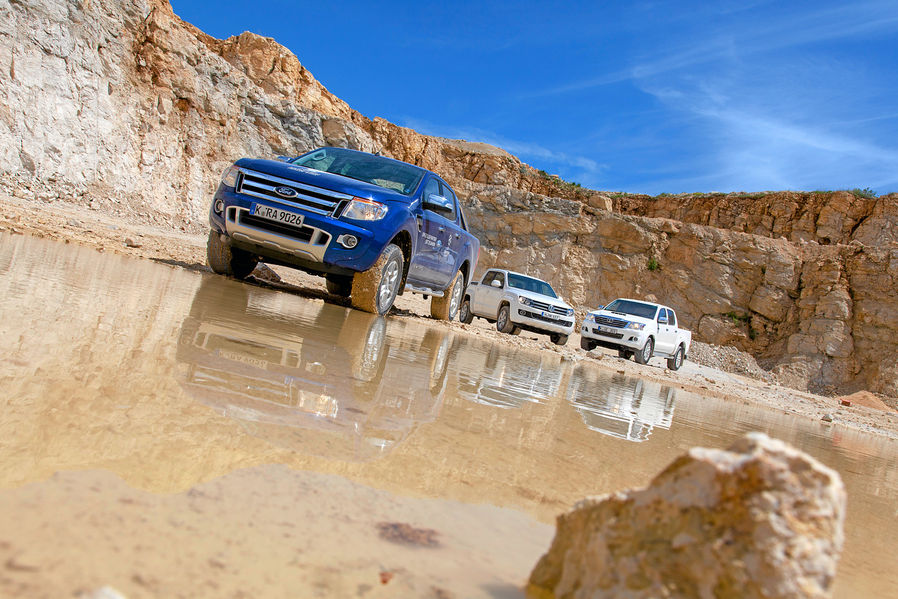
Pick-up trucks still play a comparatively minor role in the urban vehicular jungle. However, in recent years, there was a lot of movement in the market for “cool” transport vehicles. In a test of the top dogs a little less than a year ago, lastauto omnibus magazine compared the Ford Ranger, which was brand-new at the time, the Toyota Hilux, and the VW’s star entry Amarok.
Differences in Comfort
While the testers found little difference among the three competitors in terms of space, they did find differences in the levels of the comfort. The Ford Ranger was found to provide comfortable seats, good workmanship, and easy operation. The only disappointment for the experts from lastauto omnibus was the tiny five-inch GPS system. In this respect, they were happier with the Toyota Hilux solution. The modern instrumentation found approval as well. However, the uncomfortable seating position of the driver in the Hilux, caused by the steering wheel that is only height-adjustable, was a reason for criticism. The upper-leg support in front was adequate, but the testers would have liked more in the back seat.
The testers found that the VW Amarok provided exemplary ergonomics. The only advantages the Ford had over the Amarok were payload and towing capacity. The Ranger can tow up to 3.5 tons, and its impressive maximum load was 2110 lbs (960 kg). The VW can handle 3.5 tons and 1300 lbs. (590 kg), respectively. The Toyota was far behind with a towing capacity of only 2.5 tons and a payload of 1230 lbs (560 kg).
A Tie in Visibility
According to the experts, visibility tests ended in a tie. While it is fairly easy to see the front ends of all three vehicles, the rear view is blocked by steep sidewalls. Since the tall pick-ups, with a length of over 5 m (197 inches), are not exactly compact, and smaller vehicles can easily be overlooked during maneuvering, the park assist system and rear view camera in the Ford or Toyota are strongly recommended. This increases safety, in particular in overcrowded big cities.
The safety equipment of the Toyota leaves room for improvement. Tall testers complained about the narrow adjustment range of the rear headrests, and customers wanting ESP (VSC) must get the top model, the Executive. Ford offers much more in terms of safety. Even the basic model comes standard with knee airbag for the driver, in addition to ESP with hill-start assist and downhill assist control. Even the VW does not offer a knee airbag, although it impresses with highly effective brakes (cold: 116 ft [38.5 m], hot: 118 ft [35.9 m]). The Ford—cold and warm—takes more than 164 ft (50 m) to stop from a speed of 62 mph (100 km/h), whereas the Toyota needs about 144 ft (44 m).
VW Amarok Power Train Leading
The power train of the VW Amarok was the benchmark for the testers. The two-liter biturbo engine has the smallest displacement of all power trains, but, with 180 HP, is also the most powerful. The TDI impressed the testers with its smooth acceleration and quiet running. This was complemented by a very responsive eight-speed automatic transmission. With its large ratio, the transmission always offered the right drive position and, in perfect interplay with the TDI, provided the fastest acceleration for the Amarok.
As opposed to the Ford and Toyota, the VW has permanent four-wheel drive with variable power distribution for optimal traction. The 4×4 mode of the rear-driven competitors must be manually actuated. The consumption test conducted by lastauto omnibus showed the Amarok as the thirstiest with 24 mpg (9.7 liters/ 100 km) of diesel fuel. The Toyota uses 25 mpg (9.4 liters), but the 3.0-liter-D4-D with 171 HP responds slowly and does not impress. The five-speed transmission with long shifting travel is also not much fun to use. The testers judged the six-speed transmission of the Ford as less than perfect, but found it easier to use.
Frugal Ford Pick-Up
The 2.2 TDCi engine of the Ford Ranger not only provides a comparatively modest 150 HP, but it also weighs the most. During the test, however, the Diesel held its own. The testers liked the instant throttle response and the low noise level. The engine consumed only 26 mpg (9 liters), the lowest value measured. The driving dynamics of the Ranger were impressive as well. It responded well to quick changes of direction, and steering was more accurate than that of the previous model. The testers rated the driving performance of the Ford lower than that of the Amarok but above the Toyota Hilux, which was too sluggish in their view.
